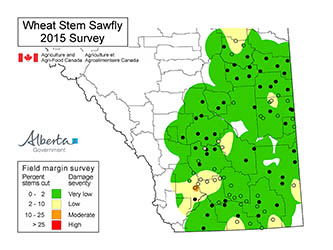| |
2016 Wheat Stem Sawfly Forecast | |
| |
|
|
| |
|
|
| |
 |
 . .
The area at risk of economically significant sawfly populations in 2016 will be limited to only a few areas. The 2015 field margin survey shows low populations in most of the area surveyed including the traditional sawfly areas in the Special Areas and the Forty Mile county.
The damage ratings are based on 93 fields in 20 municipalities. One field was found with a moderately elevated sawfly infestation in the MD of Willow Creek. Thirteen other fields were found with elevated but still low sawfly numbers in Willow Creek, Warner, Lethbridge, Vulcan, Forty Mile, Cypress, Newell, Special Areas 3 and (surprisingly) Flagstaff municipalities.
Overall the sawfly concern remains very low although there were more fields with elevated numbers and they were spread out throughout southern Alberta. This may represent the beginning of population resurgence in sawfly if dryer conditions continue.
Despite the low level of sawfly in the survey, individual fields may still have higher wheat stem sawfly populations than are indicated in the map. Overall there were zero or very low sawfly numbers in 79 of 93 (84%) of fields surveyed. (Field locations denoted by a black dot had zero sawfly found in the survey.) Thank you to Wayne Spurrill who reported sawfly damage in the Flagstaff county, as a result the survey was expanded further north to ensure this area was properly represented. |  The Wheat Stem Sawfly Map is based on cut stem counts conducted after the 2015 harvest. The Wheat Stem Sawfly Map is based on cut stem counts conducted after the 2015 harvest. |
The Wheat Stem Sawfly Map is based on cut stem counts conducted after the 2015 harvest. The percent of stems cut by sawfly gives an indication of the number of reproductive adult sawflies that will emerge in late June through early July. Winter conditions have very little impact on sawfly populations and a high proportion of wheat stems cut in the fall will produce adults. Producers in areas with moderate to high levels of cutting should consider using solid stem wheat as a control strategy.
Female sawflies lay eggs inside grass and grassy crop stems; the eggs hatch and tunnel inside stems until the crop starts to dry down near harvest. As the crop starts to ripen the sawfly larva migrates to the stem base and cuts a notch most of the way through the stem. Feeding damage from the tunneling can result in hidden yield losses of 10 to 15 percent. Further yield losses can occur from lodging at harvest. More information can be found at wheat stem sawfly life cycle.
It is possible that population hot spots still exist in areas of lower risk, individual producers need to be aware of the potential risks in their own fields.
Cutting levels higher than 10 to 15 percent in the previous crop indicate the need to consider seeding solid stem wheat to reduce sawfly losses. It is important farmers evaluate their individual situations in making their variety choices. When populations are low it is typical to have small localized populations of sawfly that affect only one field or even just a portion of one field.
The 2015 wheat stem sawfly survey was carried out by Alberta Agriculture and Forestry with support from Farming Smarter and Chinook Applied Research Association. Thank you for your contribution.
Thank you to Wayne Spurrill for reporting WSS in Flagstaff county.
Thank you Jan Lepp, Agriculture and Forestry, Brooks for managing the data from the field sheet to spread sheet.
Thank you David Giffen, Agriculture and Agri-Food Canada, Saskatoon for building the map. |
Historical wheat stem sawfly survey maps 2009-2014. |
|
| |
|
|
| |
For more information about the content of this document, contact Scott Meers.
This document is maintained by Shelley Barkley.
This information published to the web on November 24, 2015.
|
|